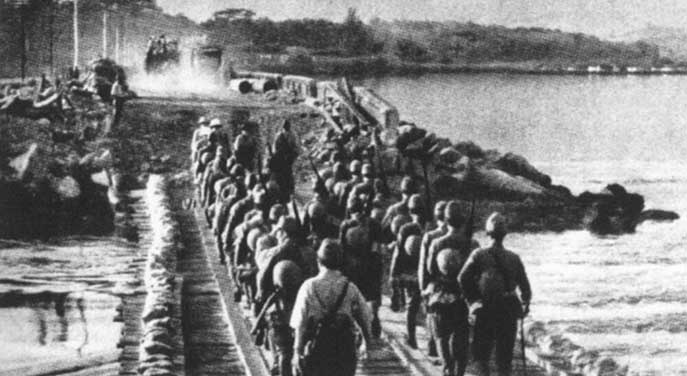 On Feb. 15, 1942, Singapore – the so-called Gibraltar of the East – fell to a numerically smaller Japanese force. Four days later, the port of Darwin in northern Australia was bombed by over 260 Japanese aircraft.
On Feb. 15, 1942, Singapore – the so-called Gibraltar of the East – fell to a numerically smaller Japanese force. Four days later, the port of Darwin in northern Australia was bombed by over 260 Japanese aircraft.
To put it mildly, Allied prospects in the Second World War’s Asia-Pacific Theatre weren’t looking too auspicious. The shock waves extended beyond the physical events.
Specifically, confidence in British power took a steep tumble. And the idea of the Royal Navy as the reliable guarantor of Australia’s security shed its last vestige of credibility.
What was known as the Singapore Strategy hinged on the large naval base Britain had commenced building in 1919. Situated on the island of Singapore and thus strategically located between the Pacific and Indian oceans, the base was intended to serve as the lynchpin for the defence of regional British interests and allies, including Australia.
There was, however, a problem. While Britain was still a major power, it no longer had the relative heft it once enjoyed. Adequately resourcing Singapore was a challenge.
So acknowledging this resource stretch, a coping strategy was put in place. In the event of war breaking out in the Pacific, the Royal Navy would be swiftly redeployed to Singapore.
But what if there was a simultaneous war in Europe?
The navy’s full might could hardly be in two places at once. And that, of course, was what happened.
Singapore’s defence was under the command of British Lt.-Gen. Arthur Percival who had a substantial force of British, Australian and Indian troops at his disposal. On paper, these resources were significantly superior to those available to the Japanese Gen. Tomoyuki Yamashita. Quality and experience, however, were a different matter entirely.
The campaign started with the Japanese invasion of the Malayan Peninsula on Dec. 8, 1941. And things instantly began falling apart.
Contrary to expectations that the jungle terrain would impede the Japanese advance, they moved rapidly down the peninsula, overwhelming whatever opposition they came across. On Dec. 10, Japanese aircraft sank HMS Prince of Wales and HMS Repulse, which cut the heart out of Singapore’s naval defence.
Having taken control of the peninsula by the end of January, the Japanese began crossing over from its southern tip to the island of Singapore on Feb. 8. Mistaken decisions with respect to positioning defenders facilitated their advance and Singapore surrendered on Feb. 15, disregarding British Prime Minister Winston Churchill’s directive that the “battle must be fought to the bitter end … and senior officers should die with their troops.” Churchill subsequently described it as the “worst disaster and largest capitulation in British history.”
Yamashita, the victorious Japanese general, didn’t disagree. Indeed, he characterized his strategy as “a bluff that worked.”
Concerned about his numerical weakness and lack of supplies, Yamashita was extremely anxious to avoid “disastrous street fighting.” So he gambled on an aggressive campaign obtaining a quick surrender. Percival obliged.
Some 130,000 Allied prisoners were taken as a consequence of the Japanese victories in Malaya and Singapore. Many of these died in captivity.
And while all wars inevitably entail atrocities, some of the Japanese brutality was particularly extreme. There was, for instance, the wholesale bayoneting of patients and staff at Alexandra Hospital. And the fearsome Sook Ching massacre slaughtered thousands of “undesirables,” mainly ethnic Chinese.
Then, just four days after Singapore’s fall, came the bombing of Darwin, which killed 252 Allied service personnel and civilians. There were to be many more such attacks over the following months and fears of a Japanese invasion were widespread.
Australia’s Labour Prime Minister John Curtin expressed a stark view: “The fall of Singapore can only be described as Australia’s Dunkirk. It will be recalled that the fall of Dunkirk initiated the Battle for Britain. The fall of Singapore opens the Battle for Australia.”
In practical terms, this implied deepening Australia’s security relationship with the United States. It wasn’t a matter of Curtin being hostile to Britain – far from it. But in a dangerous world with a predatory power on the loose, the mother country was no longer up to the job.
Lee Kuan Yew, later to become prime minister of an independent Singapore, was a young man when the island fell. For him, it was an eye-opener: “In 70 days of surprises, upsets and stupidities, British colonial society was shattered, and with it all the assumptions of the Englishman’s superiority.”
Egregious failure has consequences.
Troy Media columnist Pat Murphy casts a history buff’s eye at the goings-on in our world. Never cynical – well, perhaps a little bit. For interview requests, click here.
The opinions expressed by our columnists and contributors are theirs alone and do not inherently or expressly reflect the views of our publication.
© Troy Media
Troy Media is an editorial content provider to media outlets and its own hosted community news outlets across Canada.


